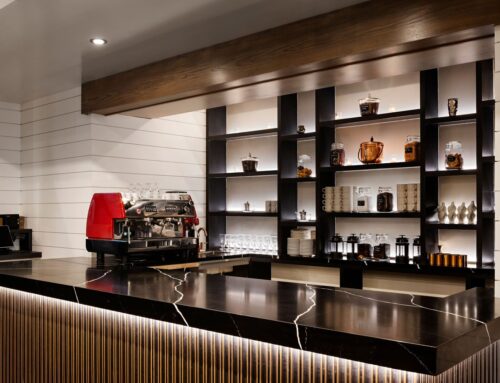Trends in hospitality interior design spaces are constantly shaping the guest experience. From boutique hotels on the shores of Long Island to chic restaurants in the heart of Philadelphia, interior design plays a pivotal role in creating unforgettable spaces.
7 Trends In Hospitality Interior Design
Whether you’re a design enthusiast or a seasoned professional, read on to discover the top trends that are shaping hospitality interior design in 2023.
1. Biophilic Design
Biophilic design is a trend that continues to gain momentum in the hospitality industry. This approach integrates natural elements and organic materials into interior spaces, creating a harmonious and calming atmosphere. Incorporating living walls, indoor gardens, and sustainable materials not only enhances aesthetics but also contributes to the well-being of guests.
2. Sustainable and Eco-Friendly Materials
Sustainability is no longer just a buzzword but a necessity in hospitality interior design. Beth Donner Design’s commitment to environmental responsibility aligns perfectly with this trend. Utilizing recycled and locally sourced materials, energy-efficient lighting, and eco-friendly furnishings not only reduces the carbon footprint but also showcases a commitment to sustainability.
3. Bold Colors and Patterns
Hospitality spaces are increasingly embracing bold colors and patterns to create visually stunning and memorable environments. Whether it’s vibrant upholstery, daring wallpaper, or eye-catching artwork, incorporating bold elements adds character and personality to spaces while leaving a lasting impression on guests. These are particularly popular for boutique motels and hotels that want to add a sense of urban charm to their design scheme.
4. Vintage and Retro Revival
Nostalgia is a powerful emotion, and the resurgence of vintage and retro design elements is a testament to that. Incorporating these elements into design projects adds a touch of nostalgia and uniqueness to hospitality spaces. Vintage furniture, retro-inspired lighting, and classic motifs are making a strong comeback. This includes art deco, mid-century modern, and even elements of nineteenth century design concepts. Sometimes the smallest detail can go a long way toward achieving a vintage look and feel.
5. Technology Integration
In today’s digital age, integrating cutting-edge technology is crucial for enhancing the guest experience. Smart room controls, interactive displays, and immersive audio-visual systems are becoming standard features in hospitality interior design. These technologies not only elevate convenience, but also offer a sense of luxury and innovation. In 2023, guests tend to expect these additions, so they’re always worth paying attention to.
6. Mixed Materials
The use of varied materials continues to be a major trend in hospitality interior design. Mixing materials such as metal, glass, wood, and stone creates dynamic and textured interiors. The juxtaposition of contrasting certain materials adds depth and character to spaces, making them visually engaging. This works especially well when you incorporate art pieces into the decor.
7. Customization and Personalization
Personalization is key in hospitality design. Custom-made furnishings, bespoke artwork, and tailored design elements ensure that every space tells a distinctive story, resonating with guests on a personal level.
Elevate Your Space With Beth Donner Designs
The world of hospitality interior design is ever-evolving, and staying on top of the latest trends is essential to create spaces that are not only beautiful but also functional and memorable. Beth Donner always has her finger on the pulse of this dynamic industry, continuously pushing boundaries and redefining the art of interior design. If you’d like to learn more, please don’t hesitate to reach out to us.



